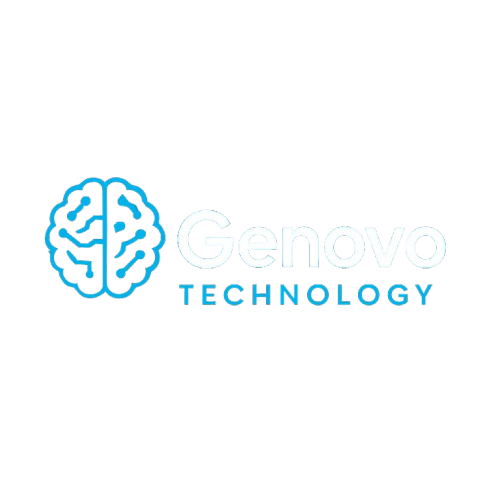Introduction
Web App and Platform Development: It might be hard to figure out how to launch a digital product, grow your business, or just get your concept into the hands of real consumers. A lot of professionals get stopped before they even start because of clumsy websites, old mobile applications, and platforms that don’t appear to work well together. Things shouldn’t be this hard, whether you own a business, are starting a new one, or are updating an old one.That’s why Web Development, App Development, and Platform Development exists: not simply to code your concept, but to make smart, scalable systems that really work, save time, and help your organisation thrive. You don’t need a lot of different companies to make your website, mobile app, and cloud platform. With the correct tools and knowledge, one strategic development team can make it all happen without a hitch.
At Genovo Technology, We’ve helped clients in the US, UK, Canada, and Australia turn rough ideas into real digital products that are fast, reliable, and made to make a difference. From unique web interfaces to high-performance apps and full-featured platforms, we design with intelligence and strategy embedded into every step. If you’re ready to stop putting things together and start constructing smart, you’re in the right place.
Are you ready to turn your concept into action?
Let’s set up a free consultation or demo, customized for your needs. Contact us now or visit our services page to get started!
What is a web app and development platform?
Let’s get things straight:
- You don’t have to download anything to use web apps; they run in your browser. Dashboards are like Google Docs.
- We do mobile apps Developmet for Android and iOS, the apps you use every day.
- Platforms are bigger ecosystems, like Shopify or Salesforce, that use APIs and backend logic to link up multiple products and services.
There is true magic when you put them all together, even if each one has its job. You may use any device to access it without any problems, and the data syncs better.

Why is the growth of Web App and Platform Development so fast?
Because time is money, computer problems may cost organisations a lot of money.
Here’s what’s driving the boom:
- AI-Powered Workflows: Automation now runs customer service, marketing, and operations.
- Serverless Architecture: Backendless and other services let you grow without having to deal with servers.
- Low-Code Tools: Teams may build quickly using platforms like Trango Tech and Imaginovation that use visual processes. This cuts development time by 60%.
Remote work, digital-first services, and scalable cloud infrastructure are all on the increase, so development is no longer simply a tech job; it’s a business benefit.
Different kinds of services for developing web apps and platforms
You have choices. Let’s look at them one by one.
Web Applications vs PWAs vs SPAs
- Web apps are regular utilities that run in a browser.
- Progressive Web Apps (PWAs) are web apps that work like mobile apps: they’re quick and can work without an internet connection.
- Single-Page Apps (SPAs): Load once and update automatically—great for dashboards.
MobiDev says that PWAs enhance engagement by 40% since they are faster and easier to use.
Genovo Technology web app and platform development services
- 1. Building a custom web app
We make interactive, scalable, browser-based apps that work on all devices. Our team makes sure that your SaaS product or dynamic e-commerce dashboard runs quickly and gives users a great experience.
Stat Insight: 87% of organisations feel online apps are crucial to their everyday operations.
(Source: Forrester Research)
- 2. Making apps for iOS and Android devices
We design and build native or cross-platform apps that feel smooth, work quickly, and keep users interested from the idea stage to the launch. We cover everything, from apps that help you work better to apps that are open to the public.
Fact: Mobile applications are very important for getting customers to interact with your business because they account for more than 72% of internet time.
(Source: Statista, 2024)
- 3. Platform Engineering & API Integration
We build backend systems, make bespoke admin panels, and connect third-party services utilising strong APIs and microservices. Our solutions work perfectly with CRMs, ERPs, analytics tools, and other software.
Fact: Businesses that use integrated platforms save 30% on manual workflows every year.
(Source: McKinsey Tech Report)
- 4. Web and app development using AI
We add AI-powered capabilities like predictive search, chatbots, voice assistants, and personalisation to your applications so that your users have better, quicker experiences.
Bonus Insight: Businesses adopting AI in their apps experienced 43% greater customer retention in 2024.
(Source: IBM AI Trends)
- 5. Kits for developing an MVP and starting a business
Start small and quickly. We assist new businesses in making minimum viable products with the most important features and the capacity to grow. These are great for getting investors or testing real consumers.
Startup Stat: MVP-first methods lower development costs by up to 40% and speed up time to market by 60%.
(Source: ProductHunt Report)
- 6. Help with maintenance, updates, and scaling
Post-launch isn’t the end—it’s just the beginning. We help you for a long time by giving you information on new features, keeping an eye on performance, fixing bugs, and giving you advice on how to grow.
Fact about Genovo clients: 92% of those who start with MVPs keep working with us through maintenance retainers.
Steps in the Development Process
- Planning and coming up with ideas
Everything starts with your idea—mapped, drawn, and confirmed. We really dig into what you need and what people want.
- Design & User Experience (UI/UX)
First impressions are important. Spaceo and Cygnis stress that design should be useful, appealing, and easy to use.
- Development of the Front-End and Backend
The front-end is what users see. Your backend runs the logic and databases. They all work together to make the whole thing work.
- Quality Assurance and Testing
We damage things on purpose—so your users never do. We test every functionality on actual devices and browsers.
- Deployment and Upkeep
It’s not enough to just launch; you also need to stay fast, safe, and up to date. Imaginovation, Kissflow, and Fuzzy Math are just a few of the teams that highlight the need for constant optimisation.
Technology Stack & Platforms to Use
- Front-End Frameworks
What technology stack and platforms to use for Front-End Frameworks
Want quickness and interaction? React, Angular, and Vue are the most popular choices, especially among developers on Pi Tech, Dribbble, and PMC.
- Databases and Backend
We create utilising trustworthy software like Node.js, Python, PostgreSQL, or MongoDB—whichever matches your app’s scalability and performance.
- Platforms for Low-Code/No-Code and AI
Want something quicker? AI-powered low-code tools help get MVPs to market rapidly, which is great for testing concepts and improving based on user feedback.
Important Problems and How to Fix Them
Let’s be real: no dev process is problem-free.
- How well it works. Bottlenecks: Fix using caching and optimised code.
- Limitations of Browsers: This is taken care of via regular testing on all devices.
- Scalability and upkeep: Use cloud-based backends and modular code to fix the problem.
Backendless, Imaginovation, and Quixy are all wonderful examples of systems that stay quick and can grow as required.
Emerging Trends Impacting Development
The future is already here.
- AI Integration: Automate support, processes, and personalisation.
- PWAs on Steroids: Apps that are even more responsive and can be installed.
- IoT and predictive analytics: apps that plan for you.
- Blockchain and serverless: more security and fewer problems with servers.
Experts from Trango Tech, Imaginovation, and Spaceo are leading these breakthroughs.
Examples and use cases from the real world
This is where it gets interesting:
- Gmail is a classic SPA.
- Facebook is a real platform.
- Budibase highlights how no-code platforms ease app production.
Businesses employ SaaS tools, bespoke dashboards, and internal portals to make HR, finance, support, and other tasks easier. And sure, it does make a difference: reduced costs, better response times, and happier users.
Picking the Right Way to Develop
So, what is best for you?
- Custom development: when you require power, control, and the potential to grow.
- Low-code platforms are great for MVPs, small teams, and testing.
If you want to grow or need flexibility, use microservices. For dashboards, use SPAs. For mobile-first sites, use PWAs.
The Future of Web App and Platform Development
- Expect AI-First Development to take over many manual operations by 2025.
- Composable Architecture provides programs that are easy to change and add to.
- Privacy-first tools that don’t give up personalisation to protect user data.
The race is on, and companies that act now will win later.
Web Apps vs Mobile Apps vs Platforms
| Feature | Web Apps | Mobile Apps | Platforms |
|---|---|---|---|
| Installation | No | Yes | Usually not (but can offer mobile access) |
| Access | Browser | Device-specific | Web, mobile, desktop |
| Offline Use | Limited | Yes | Depends on architecture |
| Development Cost | Lower | Medium to High | Varies (High for large-scale systems) |
| Update Delivery | Instant | Needs store update | Backend-controlled |
| Best Use Case | Dashboards, forms, portals | On-the-go tools, native features | All-in-one ecosystems, automation |
Frequently Asked Questions (FAQs)
- Q1. How is a web app different from a mobile app?
A web app runs in your web browser and doesn’t need to be installed. A mobile app, on the other hand, has to be downloaded from an app store and functions directly on your device, even when you’re not connected to the internet.
- Q2: Is it worth it to invest in bespoke platform development?
Yes, for sure. Companies that develop platforms that fit their workflows may boost productivity by as much as 38% and make their internal systems operate better together.
- Q3. Can I construct a platform without coding experience?
Yes. Even those who aren’t tech-savvy can make apps with today’s low-code/no-code platforms. But for scalability, complicated functionality still needs bespoke coding.
- Q4: How long does it take to finish a comprehensive Web, App, and Platform Development project?
The timelines are different. A simple MVP can take 4 to 8 weeks, while bigger business platforms can take anything from 3 to 9 months, depending on how big they are, what features they have, and how they connect to other systems.
- Q5. Do I need different teams to work on web, mobile, and platform development?
Not if you choose the correct agency. We employ cross-functional teams at Genovo Technology to manage web, mobile, and platform architecture all at once in a single, smooth process.
Conclusion and Next Steps
You got this far, so here’s what you need to know:
Web, app, and platform development isn’t just about creating code; it’s also about making a system that works well for your business and evolves with you. This development method makes things easier from design to deployment, improves the user experience, and increases your profits.
We don’t only innovate at Genovo Technology; we work with you. We help you develop smarter, grow quicker, and get more done, whether you’re starting from scratch or improving your present tech.

2 Responses